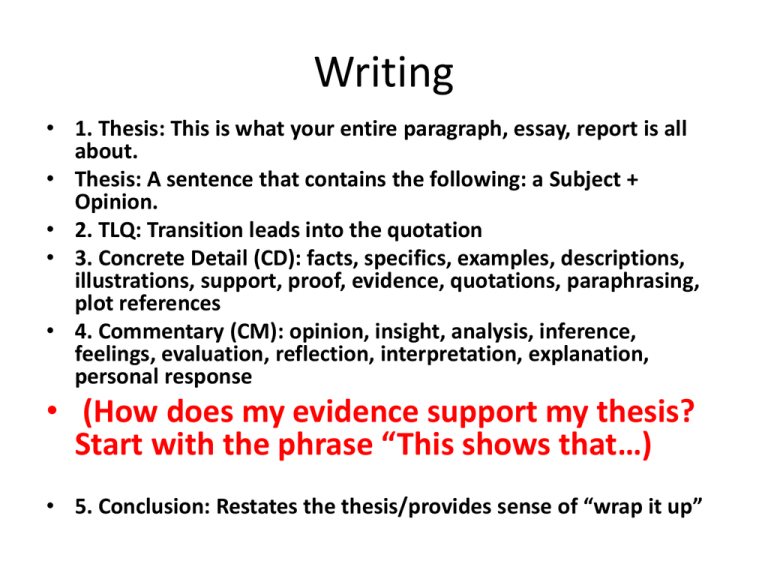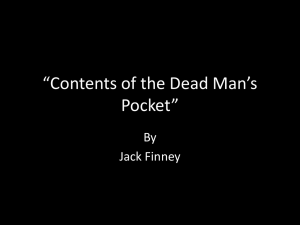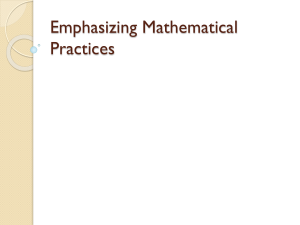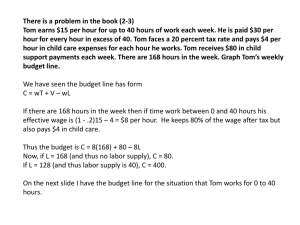Writing-Response to Literature
advertisement

Writing • 1. Thesis: This is what your entire paragraph, essay, report is all about. • Thesis: A sentence that contains the following: a Subject + Opinion. • 2. TLQ: Transition leads into the quotation • 3. Concrete Detail (CD): facts, specifics, examples, descriptions, illustrations, support, proof, evidence, quotations, paraphrasing, plot references • 4. Commentary (CM): opinion, insight, analysis, inference, feelings, evaluation, reflection, interpretation, explanation, personal response • (How does my evidence support my thesis? Start with the phrase “This shows that…) • 5. Conclusion: Restates the thesis/provides sense of “wrap it up” Rules for Writing • Follow these rules to improve your grade and your writing abilities: • 1. Always use pen/type. I will not grade it if it is in pencil. • 2. Never use a contraction. • Incorrect: I’ll never forget my trip to Disneyland. • Correct: I will never forget my trip to Disneyland. • Use the word quotation. Never use the word quote. • In this quotation, Darth Vader says, “I am your father” (Star Wars). Rules for Writing Continued… • • • • 3. NEVER use the following: I, me, you, we, us. Incorrect: I think you will like the story. Correct: Many readers will enjoy the story. 4. When you write about a story/movie/film etc. you must always keep it in the present tense. • Incorrect: Tom Beneke worked at a grocery story. Correct: Tom Beneke works at a grocery story. • 5. Never end with “In Conclusion…” “Finally…” • 6. Never start with a question Writing • A thesis is a general sentence with a subject and an opinion (CM). • Australia is the best country of all for a vacation. • Getting braces was one of the best things that could have happened to me. Writing • A thesis is a general sentence with a subject and an opinion (CM). • Australia is the best country of all for a vacation. • Getting braces was one of the best things that could have happened to me. • ________Subject • RED Opinion Identify the Subject and Opinion • • • • Fishing is fun to do when I’m with my dad. English is my favorite class. Going to a new school is exciting. Radio station Q106 is weak sauce. 4 Subjects • • • • • Think of four subjects: __________________________ _________________________ __________________________ __________________________ Thesis • Write a thesis for each of your subjects. Underline each subject once and each opinion twice: • 1. • 2. • 3. • 4. Pop Quiz 10 points • What are the 5 components and their definitions to writing? Thesis • Many times, your thesis will be based on the question/prompt. • Example: • At the beginning of the story, “Contents of a Dead Man’s Pockets,” how is Tom Beneke characterized? • Answer: At the beginning of the story, “Contents of a Dead Man’s Pockets,” Tom Beneke is work-alcoholic. TLQ • TLQ: Transition that Leads into the Quotation • Incorrect: • At the beginning of the story, “Contents of a Dead Man’s Pockets,” Tom Beneke is a workalcoholic. “On four long Saturday afternoons he had stood in supermarkets counting the people who passed certain displays” (6). TLQ • TLQ: Transition that Leads into the Quotation • Incorrect: • At the beginning of the story, “Contents of a Dead Man’s Pockets,” Tom Beneke is a workalcoholic. * “On four long Saturday afternoons he had stood in supermarkets counting the people who passed certain displays” (6). TLQ • TLQ: Transition that Leads into the Quote • Correct: • At the beginning of the story, “Contents of a Dead Man’s Pockets,” Tom Beneke is a work-alcoholic. For example, the author, Jack Finney, uses a flashback to show Tom’s determination. Tom reflects on the hours he spends at work when he remembers how “On four long Saturday afternoons he had stood in supermarkets counting the people who passed certain displays” (6). Transitions • • • • • • • • • • • For example In addition Furthermore In fact Moreover Consequently Of Course Therefore Even So Still On the Other Hand Commentary (CM) • TLQ: Transition that Leads into the Quote • Correct: • At the beginning of the story, “Contents of a Dead Man’s Pockets,” Tom Beneke is work-alcoholic. For example, the author, Jack Finney, uses a flashback to show Tom’s determination. Tom reflects on the hours he spends at work when he remembers how “On four long Saturday afternoons he had stood in supermarkets counting the people who passed certain displays” (6). CM Commentary (CM) • TLQ: Transition that Leads into the Quotation • Correct: • At the beginning of the story, “Contents of a Dead Man’s Pockets,” Tom Beneke is a work-alcoholic. For example, the author, Jack Finney, uses a flashback to show Tom’s determination. Tom reflects on the hours he spends at work when he remembers how “On four long Saturday afternoons he had stood in supermarkets counting the people who passed certain displays” (6). This flashback shows Beneke’s determination to succeed. For many employees working on Saturdays is considered over-time, and when Tom says that he has worked the last four Saturdays, it shows he is goal oriented and wants to be successful. 2nd TLQ • At the beginning of the story, “Contents of a Dead Man’s Pockets,” Tom Beneke is a work-alcoholic. For example, the author, Jack Finney, uses a flashback to show Tom’s determination. Tom reflects on the hours he spends at work when he remembers how “On four long Saturday afternoons he had stood in supermarkets counting the people who passed certain displays” (6). This flashback shows Beneke’s determination to succeed. For many employees working on Saturdays is considered overtime, and when Tom says that he has worked the last four Saturdays, it shows he is goal oriented and wants to be successful. Another example that shows Tom’s determination occurs just before he steps out onto the ledge. The narrator says Tom “knew he was going out there in the darkness” (8). This shows that Tom is willing to sacrifice his marriage and his life by walking on the ledge of a building in order to succeed at his workplace. Also, when the author uses the word darkness to describe the setting of the ledge outside Tom’s building, it adds to the story’s atmosphere, adding to the reader’s feelings of suspense about how dangerous the situation Tom is finding himself. Conclusion • At the beginning of the story, “Contents of a Dead Man’s Pockets,” Tom Beneke is a work-alcoholic. For example, the author, Jack Finney, uses a flashback to show Tom’s determination. Tom reflects on the hours he spends at work when he remembers how “On four long Saturday afternoons he had stood in supermarkets counting the people who passed certain displays” (6). This flashback shows Beneke’s determination to succeed. For many people working on Saturdays is overtime, and when Tom says that he has worked the last four Saturdays, it shows he is goal oriented and wants to be successful. Another example that shows Tom’s determination occurs just before he steps out onto the ledge. The narrator says Tom “knew he was going out there in the darkness” (8). This shows that Tom is willing to sacrifice his marriage and his life by walking on the ledge of a building in order to succeed at his workplace. Also, when the author uses the word darkness to describe the setting of the ledge outside Tom’s building, it adds to the story’s atmosphere, adding to the reader’s feelings of suspense about how dangerous the situation Tom is finding himself. Although Tom Beneke is willing to succeed at almost any cost, by the conclusion of the story he does learn that there is more to life than money. Conclusion • At the beginning of the story, “Contents of a Dead Man’s Pockets,” Tom Beneke is work-alcoholic. For example, the author, Jack Finney, uses a flashback to show Tom’s determination. Tom reflects on the hours he spends at work when he remembers how “On four long Saturday afternoons he had stood in supermarkets counting the people who passed certain displays” (6). This flashback shows Beneke’s determination to succeed. For many people working on Saturdays is over- time, and when Tom says that he has worked the last for Saturdays, it shows he is goal oriented and wants to be successful. Another example that shows Tom’s determination occurs just before he steps out onto the ledge. The narrator says Tom “knew he was going out there in the darkness” (8). This shows that Tom is willing to sacrifice his marriage and his life by walking on the ledge of a building in order to succeed at his workplace. Also, when the author uses the word darkness to describe the setting of the ledge outside Tom’s building, it adds to the story’s atmosphere, adding to the reader’s feelings of suspense about how dangerous the situation Tom is finding himself. Although Tom Beneke is willing to succeed at almost any cost, by the conclusion of the story he does learn that there is more to life than money. Find two examples of each • 1. What is the theme to CDMP’s? • 2. How is Tom Beneke characterized? • 3. How does the author create suspense? Sentence 1: Thesis Sentence 2: (TLQ)1st Concrete Detail Sentence 3: Commentary About S2 Sentence 4: More Commentary On S2 Sentence 5: (TLQ) 2nd Concrete Detail Sentence 6: Commentary About S5 Sentence 7: More Commentary On S5 Sentence 8: Conclusion 200 +words







